Permafrost Pathways attends AGU 2023
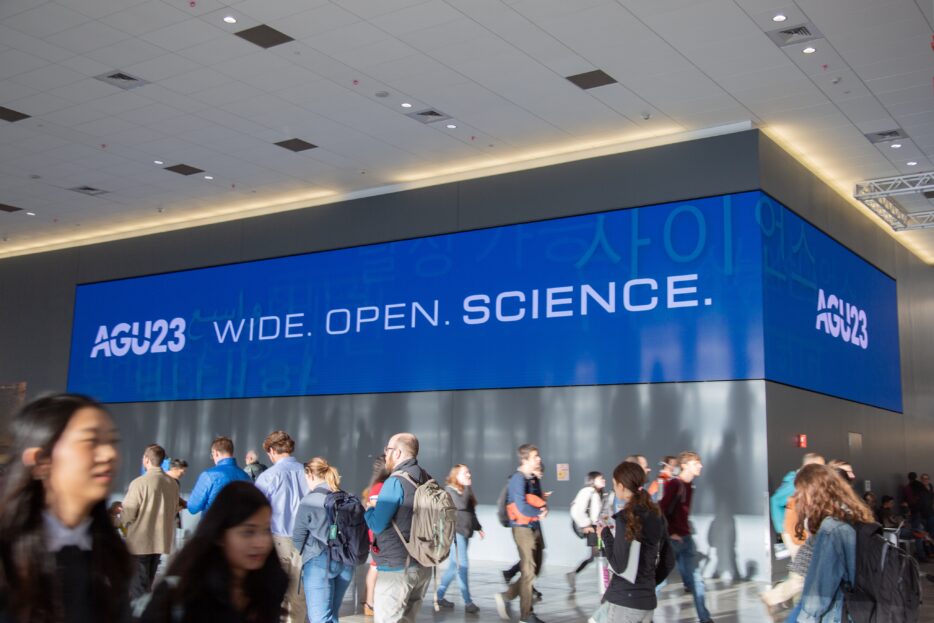
Photo courtesy of the American Geophysical Union (AGU).
Arctic Communications Strategist, Woodwell Climate Research Center
Science, policy, and geospatial teams bring new research to earth science conference
This week, thirty members from Woodwell Climate Research Center’s Arctic program–largely made up of the Permafrost Pathways team—join more than 25,000 other attendees to share their latest research at the American Geophysical Union (AGU) annual meeting in San Francisco. The team will present posters, give talks, and join panels and town halls that explore new approaches to measuring, monitoring, and addressing climate change impacts in the rapidly warming Arctic.
Explore the Arctic team’s presentation themes and times below.
8:30 AM – 12:30 PM
Poster sessions
Moscone Center, South, Poster Hall A-C
- Valeria Briones: “An integration approach to leverage existing land cover products to produce a hybrid pan-arctic land cover map for a terrestrial ecosystem model” (B21E-2005)
- Heidi Rodenhizer: “Comparison of Three Different Imagery Sources for Retrogressive Thaw Slump Detection Using a Unet3+ Deep Learning Model” (C21E-1276 – View Poster)
2:10 PM – 6:30 PM
Poster sessions
Moscone Center, South, Poster Hall A-C
- Jackie Dean: “Forecasting net forest biomass changes at 30m in forest management-relevant regions of Alaska and Canada” (B23K-2219)
9:30 – 9:40 AM
Talk
(Moscone Center 3006-West)
- Anna Talucci: “The influence of short-interval reburn disturbances on biophysical properties in the North American Boreal” (B31B-07)
8:30 AM – 12:30 PM
Poster session
(Moscone Center, South, Poster Hall A-C)
- Stefano Potter: “Mapping Alaskan and Canadian Wildfires using Convolutional Neural Networks” (B31M-2252)
2:10 – 6:30 PM
Poster sessions
(Moscone Center, South, Poster Hall A-C)
- Marco Montemayor: “Decadal differences in seasonal carbon fluxes from a subarctic fen” (B53I-1994)
- Mitch Korolev: “Wildfire and moisture availability drive shrub phenology differences in the Yukon-Kuskokwim Delta” (B33H-2339)
- Brendan Rogers: “Permafrost Pathways: Connecting science, people, and policy to advance understanding of the local to global impacts of permafrost thaw and develop just and equitable solutions” (B33H-2330)
- Woodwell Climate Polaris Project Posters: MaryBridget Horvath, Loreto Paulino Jr., Esmeralda Torres Martinez, Ambra Jacobson and JK Goongoon, Mandala Pham, Maxwell Grensted, Jordan McDavid, Aaron McDonald, Annemarie Timling
- Scott Zolkos: “Characterizing Mercury Release and Potential for Ecosystem Uptake in Permafrost Thaw- and Wildfire-Susceptible Alaskan Ecosystems” (B33I-2352)
4:00 – 5:30 PM
eLightning Session
(eLightning theater, Moscone Center South – Hall D)
- Arden Burrell: “Predicting of decadal changes in forest biomass over boreal North America at Landsat Resolution” (B34E-09) View Poster
- Joshua Rady: “Improving the Representation of Wildfire Impacts on Permafrost Carbon Storage in the DVM-DOS-TEM Ecosystem Model” (B34E-06) View Poster
8:30 AM – 12:30 PM
Poster session
Moscone Center, South – Poster Hall A-C
- Zoe Dietrich: “Autonomous Floating Chamber with Low-Cost Sensors to Measure Methane and Carbon Dioxide Fluxes from Small Water Bodies” (H41S-2029)
5:15 – 5:30PM
Talk
Moscone Center 3008 – West
- Elchin Jafarov: “Semi-Automated Calibration of Terrestrial Ecosystem Model Parameters” (B44A-08)
8:30 AM-12:30 PM
Poster session
Moscone Center, South, Poster Hall A-C
- Patrick Murphy: “Renewable energy considerations for new Arctic sites” (B51I-1886)
9:10 – 9:20 AM
Talk
Moscone Center 3009 – West
- Kathleen Savage: “Resource Acquisition, Allocation, and Biogeochemical Cycling of Carbon and Nitrogen in Permafrost Soils under Future Warming Scenarios” (B51C-05)
10:20 – 11:50 AM
Panel discussion
Moscone Center 2004 – West
- Elchin Jafarov: “Observing and Modeling of Earth Surface Cryogenic Processes and the State of Permafrost” (C52-B)
11:30 – 11:40 AM
Talk
Moscone Center 3009 – West
- Brendan Rogers for Anna Virkkala: “Upscaling Arctic-Boreal Terrestrial CO2 Fluxes: Budgets and Trends over 1990-2020” (B52D-08)
2:30 – 6:30 PM
Poster session
Moscone Center, South, Poster Hall A-C
- Kyle Arndt: “Ongoing Improvements to the Arctic-Boreal Eddy Covariance Tower Network” (B53I-1998)
- Melissa Shapiro: “A New Era for Permafrost Science-Policy Interfaces: Exploring Strategies for Enhancing the Integration of Permafrost Carbon Science, Climate Governance, and Decision-making” (B53I-1991)
- Isabel Wargowsky: “A Synthesis of Arctic-Boreal Carbon Fluxes (ABCflux v2) for Improved Carbon Budget Understanding” (B531-1992A)
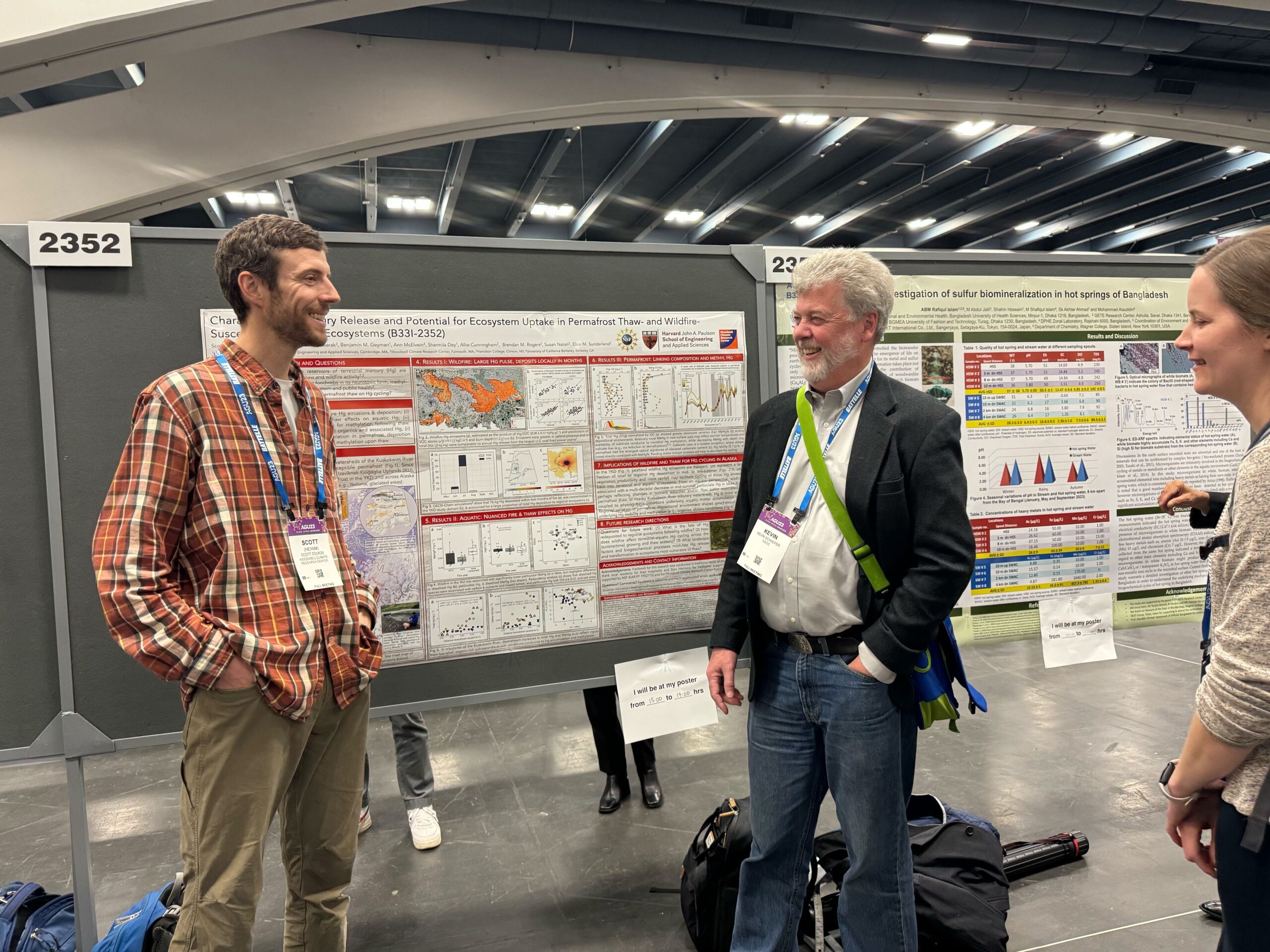
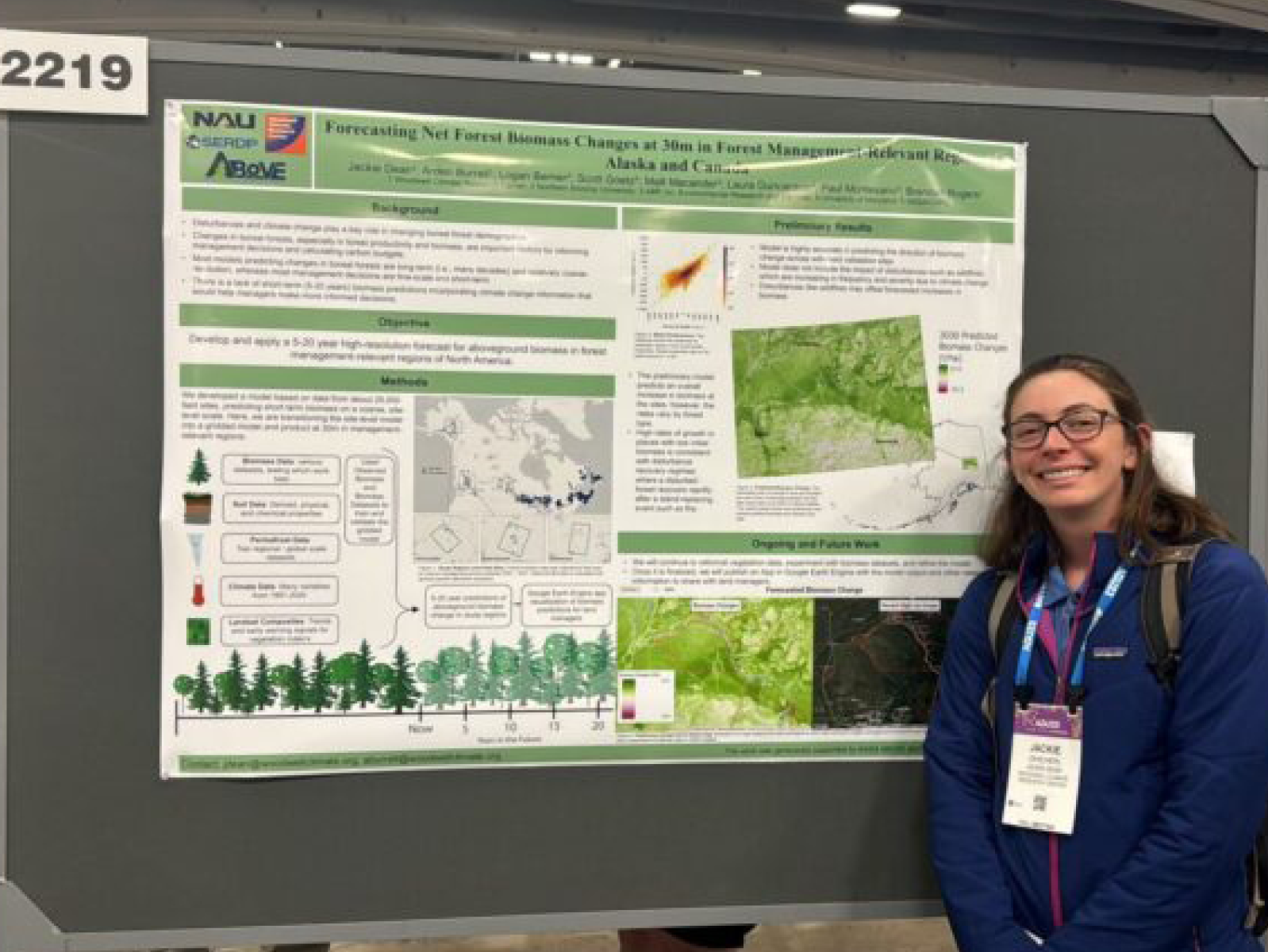
Left: Scott Zolkos discussing his research during poster presentations.
Right: Jackie Dean in front of her poster “Forecasting Net Forest Biomass Changes at 30M in Forest Management Relevant Regions of Alaska and Canada.”
Photos by Melissa Shapiro / Woodwell Climate Research Center
Throughout the week, the team responded to a few questions reflecting on their time at AGU and the impact they hope their research will have on fellow attendees.
What question do you hope a stranger walking by your poster would stop to ask you?
“I’m presenting an overall Permafrost Pathways poster at AGU, so the question I hope people ask is, ‘How can I collaborate with you all?’” – Brendan Rogers
“I would love for someone to come by my poster and inform me that, effective immediately, all satellite data is now available to researchers free of charge for scientific purposes…But recognizing that is beyond unlikely, I’d settle for the question, “what science would you like to do with a circumpolar map of Retrogressive Thaw Slumps?” – Heidi Rodenhizer
“I hope to be asked about the big picture results of what we hope to accomplish in our work. For example, once building out of the flux network is done, what are the most exciting results we expect and where do we expect to see the biggest surprises or deviations in models after incorporating the new data?” – Kyle Arndt
‘What’s next’? ‘Can I fund your research?’ wouldn’t be bad, either.” – Scott Zolkos
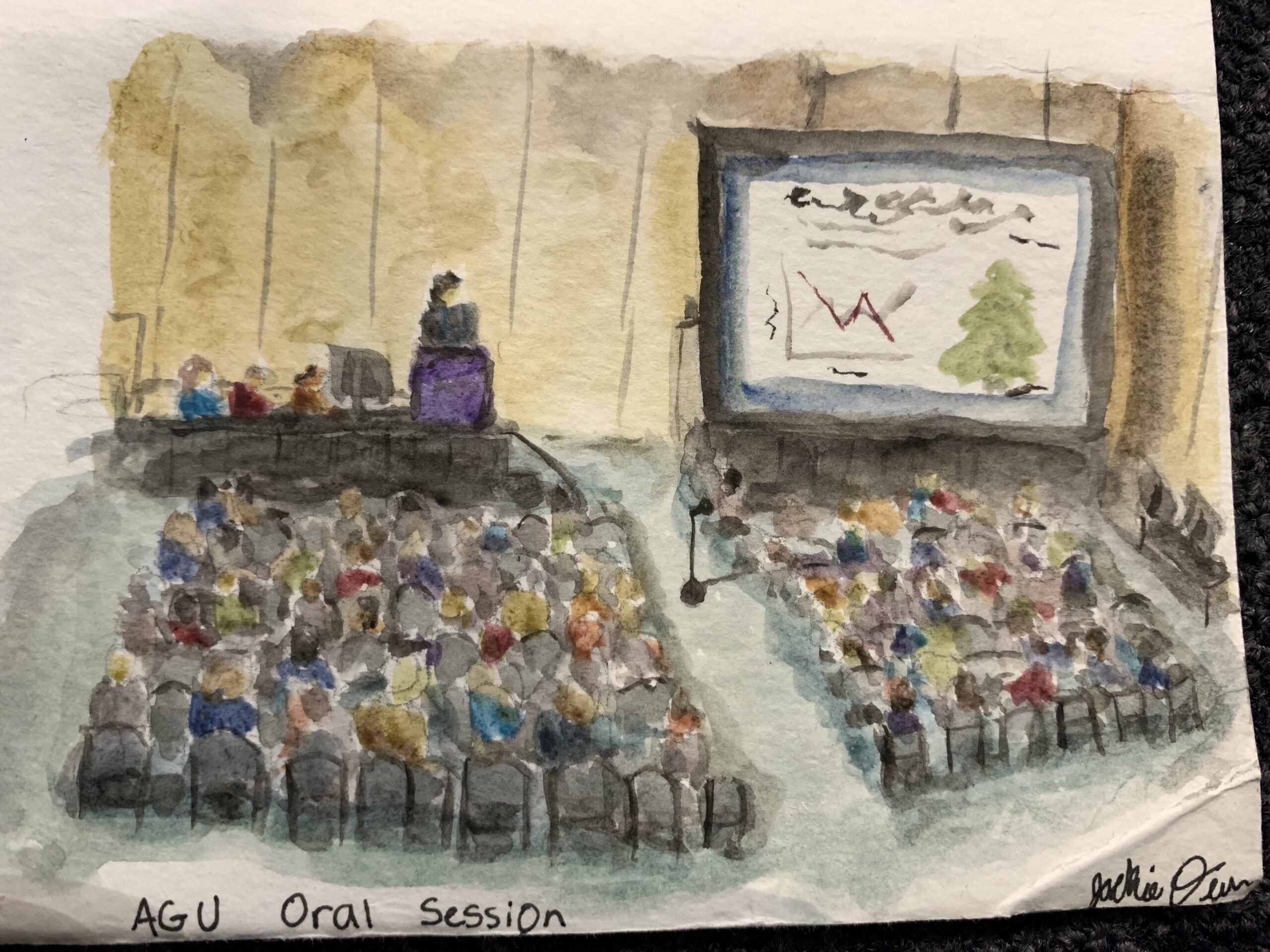
AGU oral session. Painting by Jackie Dean / Woodwell Climate Research Center
What session or AGU event are you most looking forward to?
“I always look forward to the town halls for networks and prospective projects. This year I’m attending the Fluxnet, Ameriflux (both eddy covariance networks) and ARID (possible new NASA initiative) town halls.” – Kyle Arndt
“Vulnerability of Permafrost Carbon to Climate Change: all about the Permafrost Carbon feedback from many different angles. Plus, I’ll get to see some friends from NAU there!” – Heidi Rodenhizer
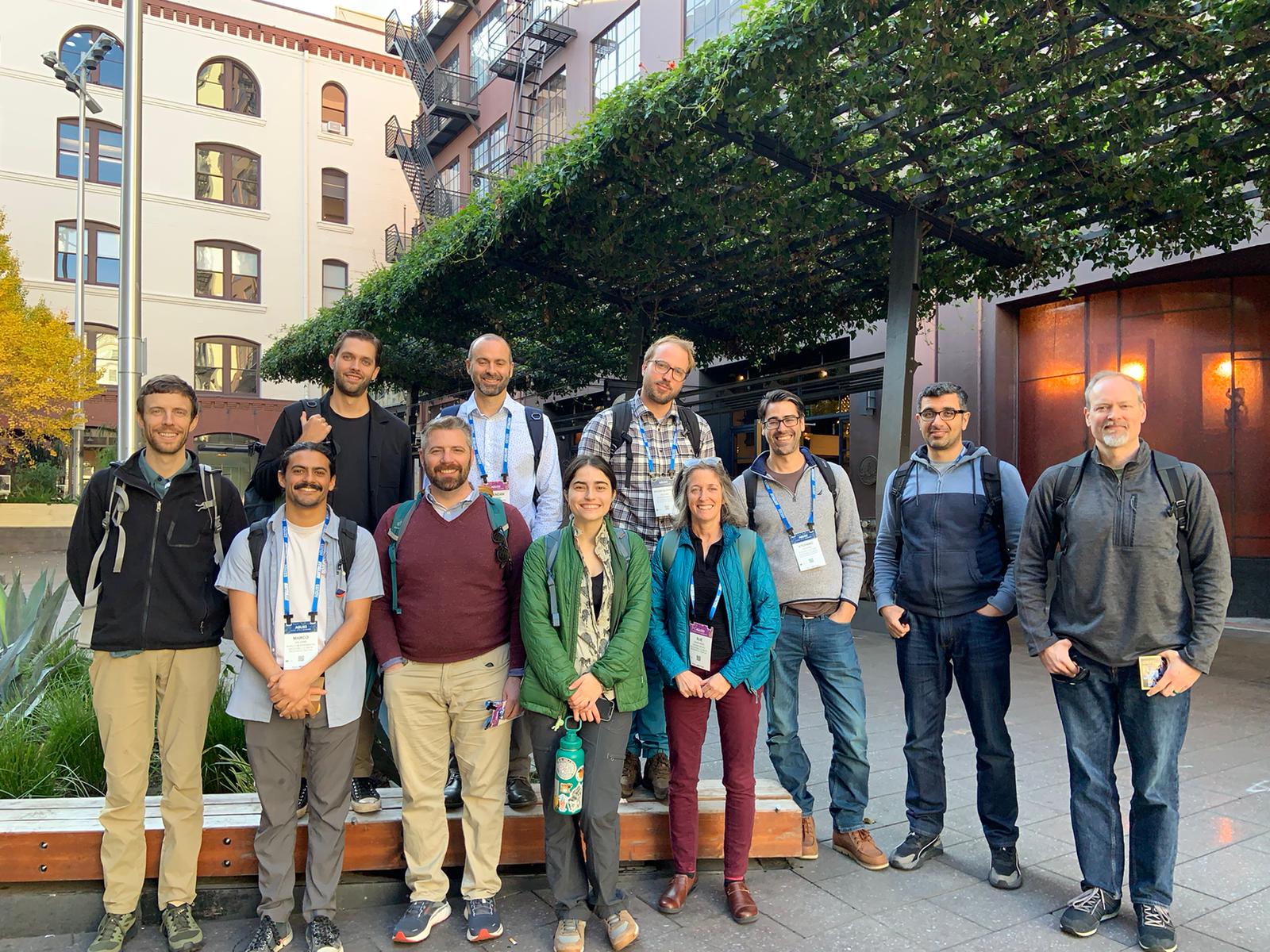
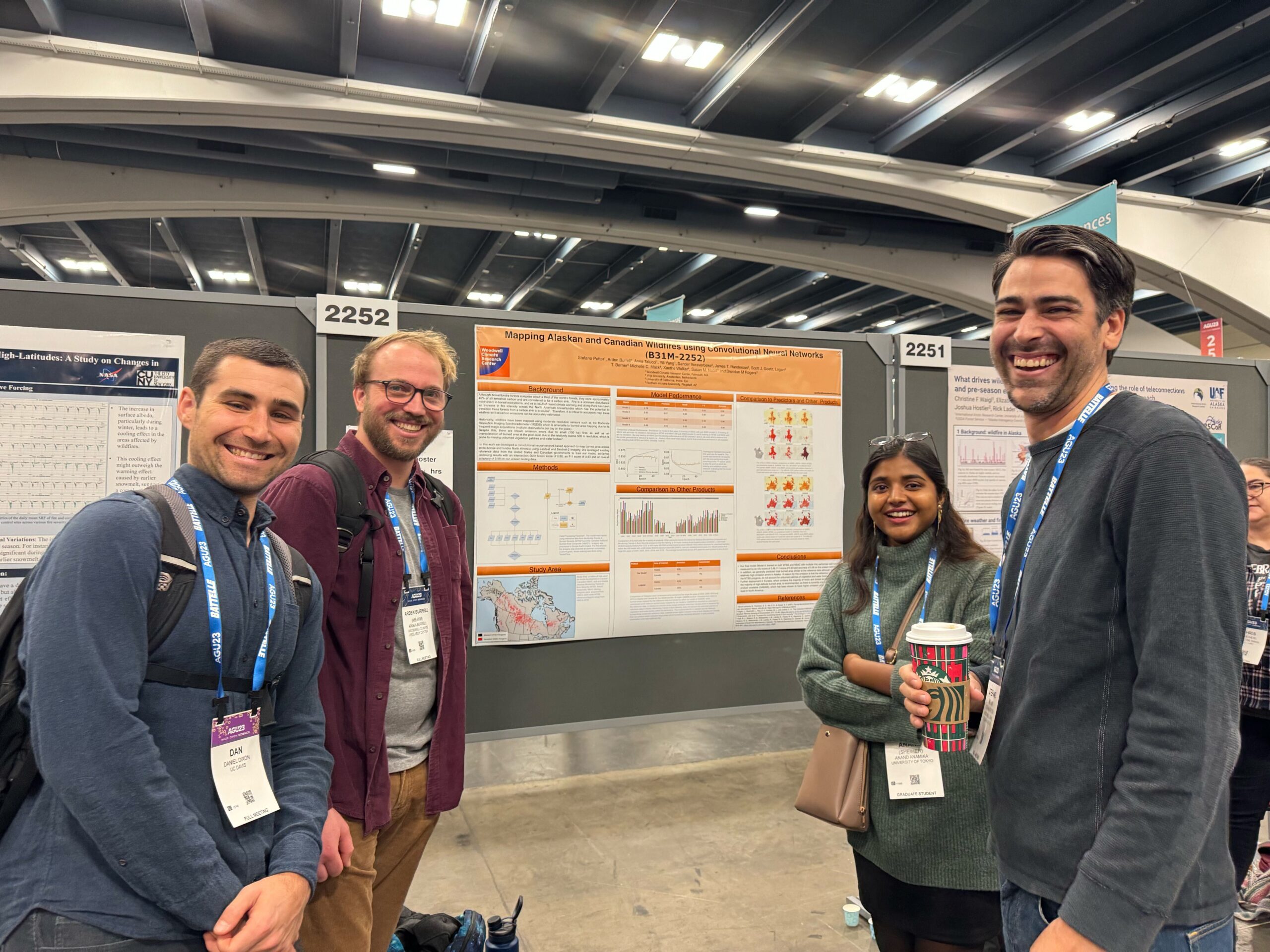
Left: Several researchers from the Permafrost Pathways team. Photo courtesy of Kyle Arndt / Woodwell Climate Research Center
Right: Stefano Potter (far right) chatting with fellow researchers during his poster presentation. Photo by Melissa Shapiro / Woodwell Climate Research Center
What’s been the best part of your AGU?
“Reconnecting with old colleagues and getting inspired by the amazing work being presented. It’s been great to chat with colleagues about the changes and new happenings, results, and opportunities they’ve had over the previous year(s).” – Kyle Arndt
“Best part of AGU has definitely been the people-seeing and catching up with old colleagues, and having quality time with many members of our team, many of whom are remote.” – Brendan Rogers
“My favorite part of AGU so far was when I presented my poster and got the chance to talk in depth about my research with so many people. It was really fun to get to connect with other researchers and learn about the commonalities between our respective studies and fields.” – Jackie Dean
Follow @WoodwellArctic on X/Twitter for more AGU 2023 updates. Visit AGU’s website to view the conference schedule at a glance.
Go to top

